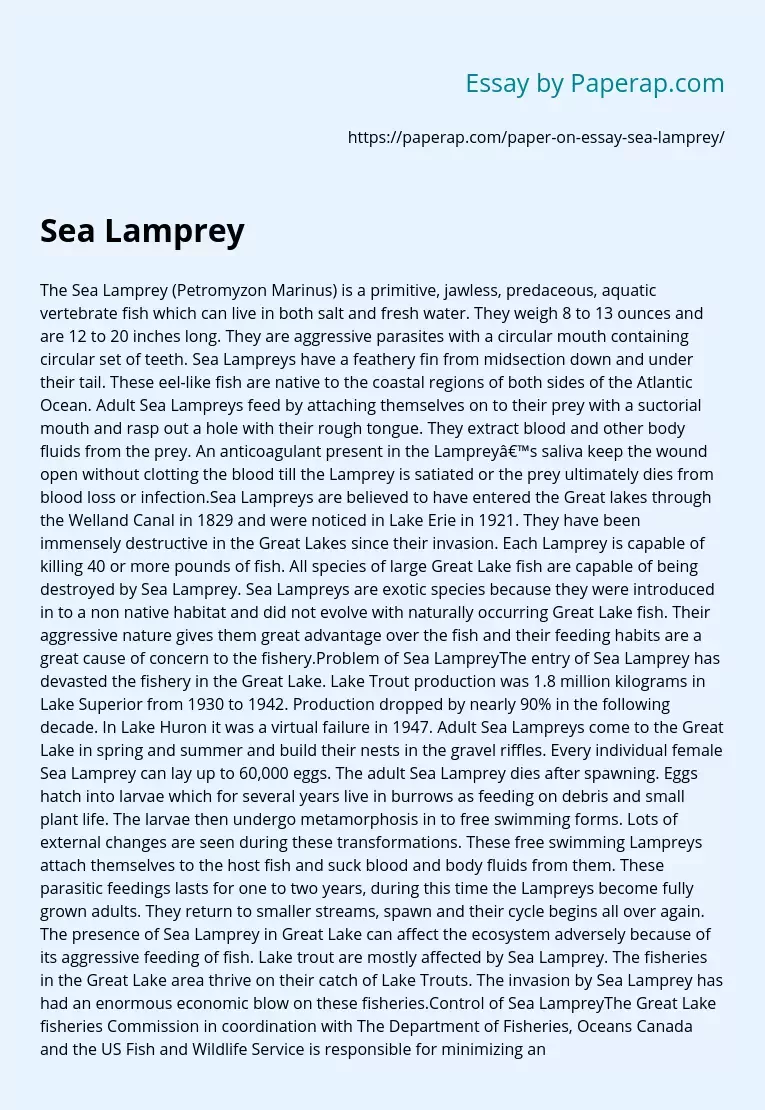The Sea Lamprey (Petromyzon Marinus) is a primitive, jawless, predaceous, aquatic vertebrate fish which can live in both salt and fresh water. They weigh 8 to 13 ounces and are 12 to 20 inches long. They are aggressive parasites with a circular mouth containing circular set of teeth. Sea Lampreys have a feathery fin from midsection down and under their tail. These eel-like fish are native to the coastal regions of both sides of the Atlantic Ocean. Adult Sea Lampreys feed by attaching themselves on to their prey with a suctorial mouth and rasp out a hole with their rough tongue.
They extract blood and other body fluids from the prey. An anticoagulant present in the Lamprey’s saliva keep the wound open without clotting the blood till the Lamprey is satiated or the prey ultimately dies from blood loss or infection.Sea Lampreys are believed to have entered the Great lakes through the Welland Canal in 1829 and were noticed in Lake Erie in 1921. They have been immensely destructive in the Great Lakes since their invasion.
Each Lamprey is capable of killing 40 or more pounds of fish. All species of large Great Lake fish are capable of being destroyed by Sea Lamprey. Sea Lampreys are exotic species because they were introduced in to a non native habitat and did not evolve with naturally occurring Great Lake fish. Their aggressive nature gives them great advantage over the fish and their feeding habits are a great cause of concern to the fishery.Problem of Sea LampreyThe entry of Sea Lamprey has devasted the fishery in the Great Lake.
Lake Trout production was 1.8 million kilograms in Lake Superior from 1930 to 1942. Production dropped by nearly 90% in the following decade. In Lake Huron it was a virtual failure in 1947. Adult Sea Lampreys come to the Great Lake in spring and summer and build their nests in the gravel riffles. Every individual female Sea Lamprey can lay up to 60,000 eggs. The adult Sea Lamprey dies after spawning. Eggs hatch into larvae which for several years live in burrows as feeding on debris and small plant life. The larvae then undergo metamorphosis in to free swimming forms. Lots of external changes are seen during these transformations. These free swimming Lampreys attach themselves to the host fish and suck blood and body fluids from them. These parasitic feedings lasts for one to two years, during this time the Lampreys become fully grown adults. They return to smaller streams, spawn and their cycle begins all over again. The presence of Sea Lamprey in Great Lake can affect the ecosystem adversely because of its aggressive feeding of fish. Lake trout are mostly affected by Sea Lamprey. The fisheries in the Great Lake area thrive on their catch of Lake Trouts. The invasion by Sea Lamprey has had an enormous economic blow on these fisheries.Control of Sea LampreyThe Great Lake fisheries Commission in coordination with The Department of Fisheries, Oceans Canada and the US Fish and Wildlife Service is responsible for minimizing and controlling Sea Lamprey. By conducting research of the life history of the Sea Lamprey it’s been found that Sea Lamprey is vulnerable during three stages of their life cycle.One is during their larval stage since they are sedentary and control would have immediate effect. Two when they are metamorphosing and migrating downstream and three when they are spawning adults, concentrated and are migrating.Currently lampricides like TFM and Bayer 73 are used to kill Sea Lamprey in their larval stage. TFM, 3-trifluoromethyl-4-nitrophenol is a pale yellow crystalline solid. Tributary streams are treated with TFM periodically depending on the abundance of larvae as TFM is potent to Sea Lamprey larvae as it causes circulatory and respiratory collapse. Mechanical and electrical barriers are constructed across the streams to control Sea lamprey during migration. The Sterile-Male-Release technique is used to control the production of Sea Lamprey during spawning. Sea Lampreys are also caught by trapping when they are migrating as adults and a portion are released after they are sterilized in order to reduce production.Effectiveness of ControlUsage of TFM as lampricide has been a tremendous success in the control of Sea lamprey. However using TFM is very costly and the Great Lake Fisheries Commission is now relying largely upon the other methods of control. Barriers reduce the area to be treated by lampricide considerably and allow passage for other species. The use of lampricide though proven to be harmful for the other species might develop a kind of tolerance in Sea lampreys which might lead to control being ineffective in spite of high costs. Various assessments programs monitor larval and spawning Sea lampreys in order to determine how and when they can be controlled. Effective control techniques have reduced the Sea Lamprey population in the Great Lake by 90%. By continuing with effective control methods their population can be kept in check so that the fisheries are not affected by them. Building various barriers in the Great Lake area and monitoring them periodically has controlled the Sea lamprey at large. The fisheries commission hopes to control this invasive species in the future too by not allowing it to upset the ecological balance in the Great Lake area.
The Sea Lamprey Fish. (2019, Jun 20). Retrieved from https://paperap.com/paper-on-essay-sea-lamprey/

